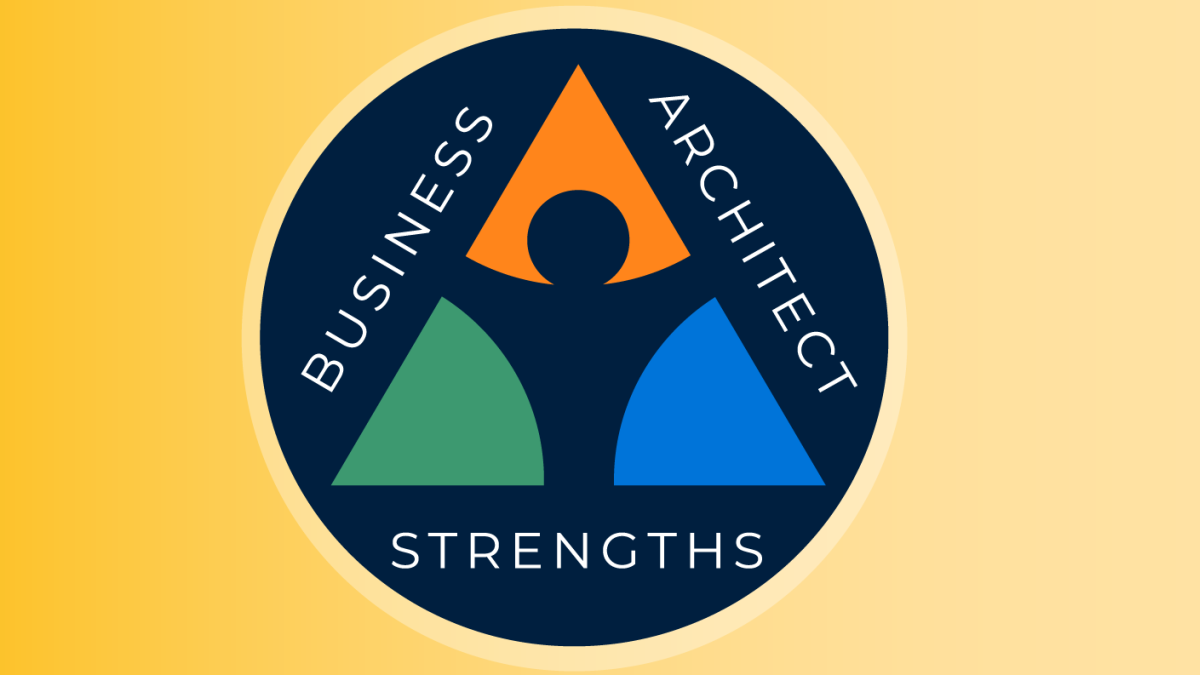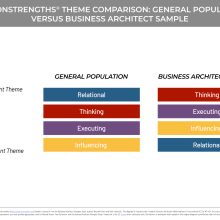A First-Of-Its-Kind Global Study
We’ve seen that there are some distinct similarities across business architects worldwide that make them well-suited for their roles. However, there is very little data-backed research currently available on the human side of business architecture. We, therefore, initiated this first-of-its-kind global, Business Architect Strengths Study to discover and share insights that can help business architects, their executives, and the industry maximize the impact of business architecture.
The Business Architects Strengths Study was a primary research effort conducted by Whynde Kuehn, an experienced business architecture practitioner and globally recognized thought leader, and Pete Cafarchio, a certified coach by the International Coach Federation as well as a Certified Strengths Champion. The study was comprised of 68 business architecture practitioners from 14 countries, with varying levels of experience, responsibilities, perspectives, and personalities.1 The study was based on two key inputs from each study participant: their Gallup CliftonStrengths® Full 34 report and their responses to a questionnaire about their role and job satisfaction. The study concluded in March 2020.
Our study is primarily targeted towards business architecture practitioners and their executive leaders. However, it also provides valuable input for hiring managers, human resources associations, universities, industry professional associations, and other interested stakeholders.
Purchase the complete Business Architects Strengths Study. Included with the full report is a short summary suitable for executive leaders plus other valuable resources to help you interpret, share, and move insights into action.
A Snapshot of the Findings
The full report contains numerous insights into business architects’ talents and practical suggestions for maximizing their effectiveness. However, a few of the findings really caught our attention.
(1) While the top Signature Strengths for business architects closely mirror those of the general population, many business architects have two less-common strengths in their top 10 that give them a distinct advantage:
- Connectedness has an average ranking at #8 of 34 for business architects, versus #22 for the general population.
- Intellection has an average ranking at #9 of 34 for business architects, versus #20 for the general population.
(2) As a category, Relational strengths rank highest in the general population, but lowest with business architects (see graphic).(3) The three talents of Harmony, Empathy, and Adaptability are all Relational strengths. They occur with high frequency in the general population but occur very infrequently with business architects.
These findings and others we discovered through the study provide real data that help to explain why we see certain results occur across organizations. For example, the superpower of Connectedness explains why business architects so are readily able to “connect the dots” across strategy and execution, between business units, and between business and technology. On the other hand, the Non-Pattern strength of Empathy provides some perspective on why business architects may be challenged to win over executives and other key influencers.
Furthermore, when we combined the collective strengths results with the results from their role and job satisfaction questionnaire, we identified some common misalignments in business architect responsibilities within organizations. The study goes deeper into the why of those misalignments, with practical suggestions of how business architects and their leaders can create targeted action plans for adjustments and skills development.
Relevance and Applicability
The results of this study can be leveraged by business architecture practitioners, executive leaders, and other stakeholders to:
- Explain, advocate for, and maximize the unique perspectives and strengths that business architects bring to the table.
- Provide a common language to talk about the strengths of business architects as well as their collaboration with others.
- Identify areas for emotional intelligence and personal leadership development.
- Inform the formalization of the business architect role and competencies.
- Give further credence to the distinctive role and discipline of business architecture.
There has never been a greater need for a well-informed, holistic view to make the best use of our human talent resources. Business architects are special, passionate people with unique strengths and abilities. The results of this study can help to maximize and unlock the special abilities business architects bring to build better organizations and societies, with a new vision for how we execute strategy, collaborate, and create value.
Download the Study Brief
You can download a copy of this study brief below.
Inquiries
If you have comments on the study or would like to participate in future research efforts, we want to hear from you.
We are also supportive of universities, industry professional organizations, and journals focused on business architecture and enterprise architecture, strategy execution, human resources, and other topics. If you are interested in a research briefing, article, or other collaborations, please contact us for more information.
View the press release here.
- 1We do not claim that our sample size is representative of business architects worldwide. Nonetheless, we do believe the research has uncovered insights that are valuable to the business architect community.



